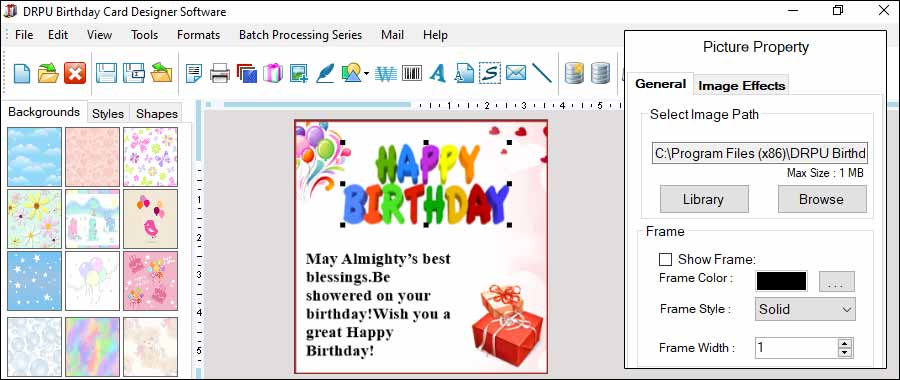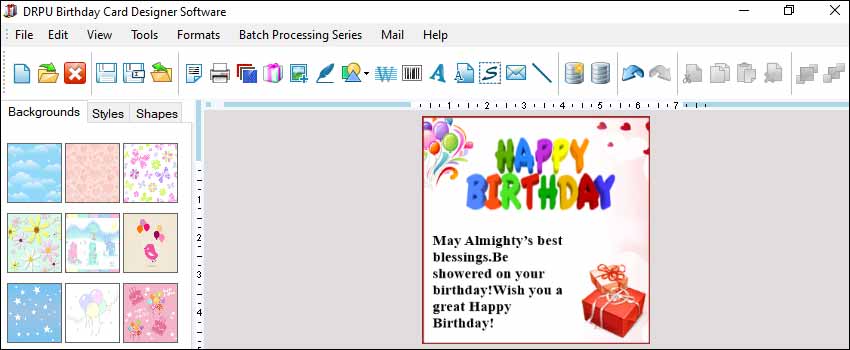Emerging Technologies and Features in Birthday Card Maker Software
As technology continues to evolve, there are several emerging technologies and features that are starting to appear in birthday card maker software.

Here are some of the most exciting developments:
-
Machine learning:
Machine learning is a technology that allows computers to learn from data and improve their performance over time. In the context of birthday card maker software, machine learning can be used to suggest design elements or layouts based on a user's past preferences. For example, if a user tends to favor certain colors or patterns, the software could suggest similar options for future designs.
-
Augmented reality:
Augmented reality (AR) is a technology that allows users to interact with virtual objects in the real world. In the context of birthday card maker software, AR could be used to create interactive designs that incorporate 3D objects or animations. For example, a birthday card could include a virtual cake that the recipient can "blow out" by blowing into their phone's microphone.
-
Virtual reality:
Virtual reality (VR) is a technology that allows users to interact with virtual environments using a headset or other device. In the context of birthday card maker software, VR could be used to allow users to preview their card designs in a virtual environment before printing them. This could help users to visualize how their design will look in real life and make any necessary adjustments.
-
Voice recognition:
Voice recognition technology allows users to control their devices using voice commands. In the context of birthday card maker software, voice recognition could be used to allow users to dictate text or navigate the software without using their hands. This could be especially useful for users with disabilities or who prefer hands-free interactions.
-
3D printing:
3D printing allows physical objects to be created from digital designs. In the context of birthday card maker software, 3D printing could be used to create custom, three-dimensional birthday cards that incorporate intricate designs or features. For example, a birthday card could include a pop-up element that is created using 3D printing.
-
Artificial intelligence:
Artificial intelligence (AI) is a technology that allows computers to perform tasks that typically require human intelligence, such as recognizing images or understanding natural language.
In the context of birthday card maker software, AI could be used to help users create more personalized designs based on data such as their age, interests, or relationship to the recipient.
Overall, As these emerging technologies continue to develop and become more accessible, they have the potential to revolutionize the way we create and interact with birthday cards. Whether it's using machine learning to suggest design elements or incorporating augmented reality to create interactive designs, these technologies are sure to play a significant role in the future of birthday card maker software.
Choosing The Right Printing Method and Paper for your Birthday Card
Choosing the right printing method and paper is a crucial step in ensuring that your birthday card designs look their best. Here are some factors to consider when making these decisions:
-
Printing Method for Birthday Card Design:
There are several different printing methods to choose from, each with its own advantages and disadvantages:
-
Digital printing: Digital printing is a popular choice for small print runs or when speed is a factor. It uses inkjet or laser printers to produce high-quality prints quickly and affordably.
-
Letterpress printing: Letterpress printing is a printing method that uses a raised printing plate to press ink onto paper. It produces a distinct, tactile look and feel and is often used for high-end stationery.
-
Offset printing: Offset printing is a traditional printing method that uses a printing plate to transfer ink to paper. It is best suited for large print runs and can produce high-quality prints with precise colors and details.
When choosing a printing method, consider factors such as the quantity of cards you need, the level of detail in your design, and your budget.
-
-
Paper for Birthday Card Design:
The paper you choose can have a significant impact on the look and feel of your birthday cards. Here are some factors to consider when choosing paper:
-
Weight: Paper weight is measured in grams per square meter (gsm). For birthday cards, a weight of 250-300 gsm is recommended for a sturdy, high-quality feel.
-
Finish: There are several different paper finishes to choose from, including glossy, matte, and textured. Glossy paper has a shiny, reflective surface that can make colors appear brighter and more vibrant, while matte paper has a non-reflective surface that can give designs a more subdued, elegant look. Textured paper has a tactile feel and can add depth and dimension to designs.
-
Color: The color of your paper can also have an impact on your design. White or cream-colored paper is a classic choice that can make colors pop, while colored paper can add a unique, playful touch.
When choosing paper, consider factors such as the overall aesthetic of your design, the level of durability you need, and your budget.
-
In addition to these factors, it's also important to work closely with your printer to ensure that your design is compatible with their printing equipment and methods. They can also provide recommendations and samples to help you make the best choices for your birthday card designs.
Birthday Card Maker have Some Popular Options
There are many different birthday card maker software options available on the market today, ranging from basic, free programs to more advanced, professional-grade software. Here are some of the most popular options:

-
Canva:
Canva is a popular online graphic design tool that offers a range of templates and design elements for creating birthday cards. The platform is known for its user-friendly interface and drag-and-drop functionality, making it easy for even novice designers to create professional-looking designs.
-
Adobe Spark:
Adobe Spark is a web-based design tool that offers a range of templates and design elements for creating birthday cards, including animation and video capabilities. The platform also integrates with other Adobe products, such as Photoshop and Illustrator, for advanced design features.
-
Fotor:
Fotor is a free online photo editor that includes a range of templates and design tools for creating birthday cards. The software also offers advanced editing features, such as color correction and image retouching, for more professional-looking designs.
-
Greetings Island:
Greetings Island is an online card maker that offers a range of customizable templates and design tools for creating personalized birthday cards. The platform also includes a range of other cards and invitations, making it a versatile option for all types of events.
-
Hallmark Card Studio:
Hallmark Card Studio is a desktop software program that offers a range of templates and design tools for creating personalized greeting cards, including birthday cards. The software also includes a range of advanced features, such as photo editing and clip art, for more professional-looking designs.
-
PrintMaster:
PrintMaster is another desktop software program that offers a range of templates and design tools for creating personalized greeting cards, including birthday cards. The software includes advanced design features, such as color correction and image retouching, for more professional-looking designs.
-
Smilebox:
Smilebox is a web-based design tool that offers a range of templates and design tools for creating birthday cards and other digital invitations. The software also includes a range of animation and video capabilities, making it a fun and engaging option for digital cards.
Birthday Card Designs are of High Quality and Meet your Printing Requirements
When designing birthday cards using a birthday card maker software, it is important to ensure that the final design meets your printing requirements and is of high quality. Here are some steps you can take to achieve this:
-
Use high-resolution images:
Low-resolution images can appear blurry or pixelated when printed, so it's important to use high-resolution images (at least 300 dpi) in your design. If you are using images from the internet, make sure they are large enough for print and that you have permission to use them.
-
Set up the document correctly:
When setting up your document, make sure that you have the correct bleed, trim, and safety margins. Bleed is the area outside of the final trim where the design extends to ensure that there are no white edges after trimming. Trim is the final size of the card, and safety margins are the minimum distances from the edge of the document where important elements like text or logos should be placed.
-
Check colors:
Make sure that the colors in your design are set up correctly for print. Use CMYK color mode rather than RGB, which is designed for screen display. CMYK uses a four-color process to create all colors (cyan, magenta, yellow, and black), while RGB uses three colors (red, green, and blue). Colors can also look different on different screens, so it's a good idea to check a printed proof to ensure the colors are accurate.
-
Preview the design:
Use the preview function in your birthday card maker software to ensure that the design looks the way you want it to. Check for any spelling or grammar errors, make sure images and text are aligned correctly, and ensure that there are no elements outside the bleed area.
-
Print a test copy:
Before sending your design to print, print a test copy to check for any issues or errors. This can also help you ensure that the colors are accurate and that the design looks the way you want it to.
-
Work with a professional printer:
Finally, working with a professional printer can ensure that your birthday card designs are of high quality and meet your printing requirements. They can provide guidance on paper selection, printing methods, and other factors that can impact the final product.
By following these steps, you can ensure that your birthday card designs are of high quality and meet your printing requirements.